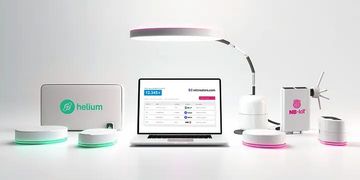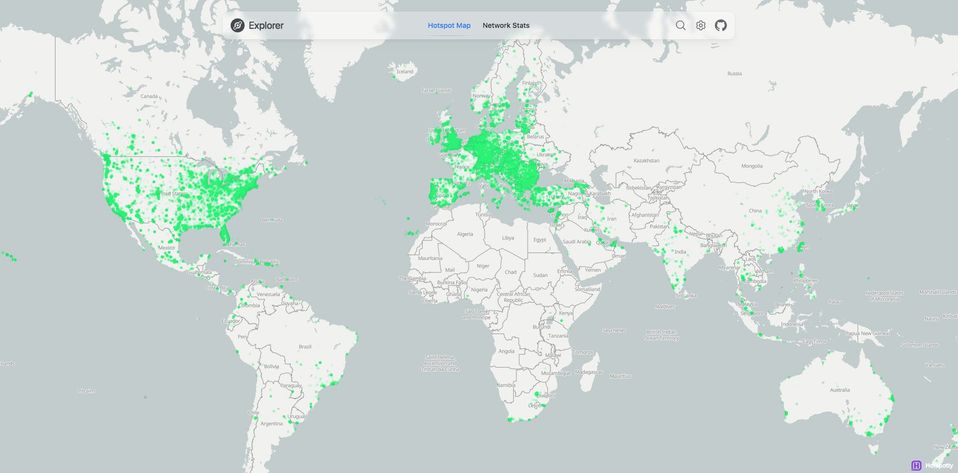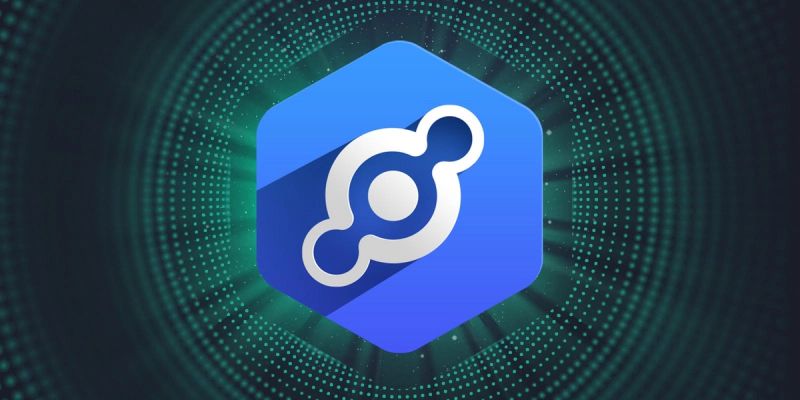Helium is an exciting blockchain project that aims at nothing short of decentralising the way smart devices communicate with each other.
In this article, you will find all the information you need about Helium, to make an educated guess whether you want to put it on your radar or not.
- Helium Network’s innovative approach is disrupting the IoT and the telecom industries. In 2020, the IoT industry revenues were $182 billion and are forecasted at $621 billion by 2030. Mobile operators, on the other hand, generated a massive revenue of $1.07 trillion in 2022.
- Helium started out as an Internet of Things (IoT) Network for communication between smart devices. The coverage was provided by Hotspot devices, which would double as a wireless access point and a miner.
- Helium Network has scaled to hundreds of thousands of these Hotspot devices, providing extensive coverage in the USA, Europe and most other big urban areas. It is a big player in the Long Range Wide Area Network (LoRaWAN) industry.
- The rapid expansion meant more and more data bandwidth was required, and the project ran into scaling difficulties. In response, the team implemented two Helium Improvement Proposals, HIP-51 and HIP-70.
- These HIPs proposed migrating the Helium Network from a standalone blockchain instead to Solana, which would enable the scalability the Network requires. The proposals also outlined a more efficient infrastructure in which different networks (LoRaWAN, 5G, etc.) would become mutually dependent entities called subDAOs.
- The team successfully migrated to Solana in Q2 of this year. Soon after, Nova Labs announced the rollout of their Helium Mobile unlimited pack, with an enticing offer of unlimited text, talk and data for $5 a month. It is currently only available in the USA.
- Helium’s unique approach to providing decentralised coverage in exchange for token rewards has proved itself to be very effective. The last years not only proved that there is demand but it also showed the Helium team’s resilience. The scaling solution they implemented was technically challenging, bold but efficient.
- At the time of writing, the market cap of Helium Network Token (HNT) is approximately $209 million. Helium follows a 2-year halving cycle, which will cap the max supply to ~213.5M million tokens. There are currently 156 million HNT in circulation, according to Solscan.
1. Timeline Overview
1.1 Original Vision
Shawn Fanning was the founder of Napster, a file-sharing application, and after meeting Amir Haleem, they discussed how to recreate the model of Napster. In 2013, they, together with Sean Carey, founded Helium Systems, a wireless network and blockchain company based in San Francisco.
Helium started out as a blockchain with the aim of providing a decentralised Internet of Things (IoT) network for smart metres and similar devices. The Helium Network was launched in 2019 with the mission of delivering a decentralised, open-source, accessible, and secure wireless network for the entire world.
It is now the largest LoRaWAN network in the world, with hundreds of thousands of Hotspots deployed. More on that in the sections below.
1.2 Helium Improvement Proposals (HIPs)
The Helium Network grew very quickly, and it now has Hotspots deployed around the world. The data usage was ever-increasing, and the team needed to find a more scalable solution.
In January 2022, the team proposed a Helium Improvement Proposal (HIP-51), within which the team proposed changing the existing business model. They proposed that each wireless network built on top of them (e.g. LoRaWAN, WiFi, 5G, VPN etc.) have their own subDAO and its own token.
The key specifications of the DNP, such as Proof-of-Coverage rules, mining rewards, and Data Transfer pricing, are governed by each DNP subDAO. The model proposed required that the entire Helium network (tokens, Hotspots, emission rules, governance, etc.) lives on an existing base layer blockchain.
Following the acceptance of the proposal from the community, HIP-70 was put forth by the team in August 2022 and entailed migrating the network to Solana. It was also voted in by the community.
1.3 Solana Migration
Helium successfully migrated to the Solana blockchain in April this year. This was an impressive feat of achievement, arguably similar to that of The Merge last year. This has huge implications for the scalability potential of the Helium network. Core Helium developers don’t have to maintain the base layer blockchain anymore, which allows them to focus on other priorities.
This strategic move aims to capitalise on Solana's scalability, low transaction costs, and high-performance capabilities, including its fast transaction throughput and energy-efficient consensus mechanism.
The migration to Solana offers key benefits for the Helium Network: it enables the IoT and Mobile networks to support even greater scale, supports more sophisticated Proof-of-Coverage algorithms, and enhances the network's resilience, making it an even more robust solution for high-demand applications.

2. Product
As discussed in the previous section, the migration to Solana now allows for a different structure that has evolved Helium into a network of wireless networks. For the time being, these include the LoRaWAN and the 5G networks, but others can be added quickly.
2.1 Helium LoRaWAN
The LoRaWAN network was the initial starting point for Helium. This wireless network's target use case is communication between smart devices that don’t require a lot of data. The coverage is provided by the so-called Hotspots.

2.1.1 Hotspots
Hotspots are wireless devices that provide long-range, low-power internet communication, with the intent to be used by smart devices to communicate with the internet. Let’s see what happens when a smart device wants to send some data through a Hotspot.
It sends it to a Hotspot in range, and the Hotspot will recognise where it is coming from, thanks to a unique identifier in the blockchain. The Hotspots forwards the LoRaWAN message to the Helium Packet Router, which in turn delivers it to the device owner.

If the target device wants to see the full message, it sends payment to the Hotspot in the form of Data Credits (DC) at the price of 1 DC ($0.00001) per 24 bytes of data. Users can use a credit card and set up a recurring payment or burn HNT in order to obtain DC.
Practically speaking, if you run 5 devices that send 12 standard-sized (24 bytes) messages per hour, it would cost you a little over $5 a year. They have a handy calculator on their website, where you can see how much the data would cost with different setups.

There are a variety of these Hotspots available from different manufacturers – all serving the same purpose, ubiquitous LoRaWAN coverage. The Helium website also features the Explorer, a world map with currently deployed Hotspots. Users can also find help to find the optimal position to place these Hotspots.
The Helium Network uses a unique work algorithm known as Proof of Coverage (PoC) to verify that Hotspots are accurately representing their location, configuration, and the wireless coverage they provide. This system is designed to incentivise Hotspot operators to deploy Hotspots in underserved areas and report their deployments accurately. The network was designed in this way to ensure optimal utility for users leveraging this coverage for the purpose of deploying sensors or other smart devices.
2.2 Helium Mobile and Helium 5G Network
In September last year, the Nova Labs team announced Helium Mobile and followed through in June this year, starting in the USA. The company offers a mobile carrier service that runs on a combination of nationwide coverage and Helium 5G network. The team claims that they deliver superior coverage at a lower cost and reward users along the way.

Helium Mobile’s Dynamic Coverage model converges different types of wireless infrastructure built and maintained by real people. This includes CBRS radios, wireless hotspots and others to provide connectivity for Helium Mobile users at a lower overall cost. In areas where Helium coverage is weak, users can seamlessly roam to the T-Mobile network.
Helium Mobile launched in Miami, but as they have shown us with the IoT coverage, a decentralised approach with incentives can mean exponentially faster growth. Users can take advantage of the opportunity to earn MOBILE rewards by opting into passive sharing of their location data, known as mapping. They can also buy a mobile hotspot device and provide coverage in incentivised areas.
2.3 Network Overview

3. Team
The Helium project was initiated in 2013 by Amir Haleem, Shawn Fanning and Sean Carey.
Amir Haleem is one of the original founders who is still actively involved in the project. He is recognised as the CEO and co-founder of Helium and is also the founder of Nova Labs, the company behind Helium Mobile. He was previously a Co-Founder and CTO at Diversion Inc., an online entertainment company.
Abhay Kumar is the CEO of the Helium Foundation, a non-profit organisation that stewards the Helium Network. Abhay has an impressive resume, starting in the Software Engineering and Mathematics background.
Scott Sigel is the COO of the Helium Foundation. He, too, has an impressive resume. In 2020 he also served as a Strategic Advisor to Solana and Arweave.

4. Industry Overview
There are two major industries, Helium is taking on - the Internet of Things (IoT) and, more recently, the telecommunications industry or telecom for short. Both of these industries are enormous in size.
According to Statista, the IoT global revenue is estimated at approximately $300 billion annually, with the number projected to more than double by 2030. The telecom industry is even larger and was estimated to be worth $1.74 trillion in 2020 in a report by Grand View Research.
Traditionally, the wireless communication industry was dominated by large corporations due to the high capital investment required, difficulties with building and maintaining the infrastructure and the fact that this environment is typically highly regulated. We are happy to witness a more decentralised and open-source initiative take place.
4.1 Coverage and ease of expansion
Helium’s natural advantage over the telecom giants is its flexibility when it comes to expansion. While the giants of the old have heavy infrastructure in place, Helium's innovative approach of incentivising humans to place Hotspot devices has proven to be ingenious.
While large urban areas are still dominated by the telecom giants, Helium’s model provides a much more sensible solution to providing coverage in remote areas. The problem with traditional companies is that they don’t want to build the infrastructure if there are not enough households they will benefit from in the future.
With tokenisation also comes the power to incentivise a particular area, should it make sense to focus the attention there.
But while Helium may have the wind in their sails, telecom giants are surely not oblivious to their success, and they may start investing in similar hardware, helping them expand more efficiently.

4.2 Other comparisons
An important philosophical aspect of the standard Web2 vs Web3 question that must be asked every time is ethics. Is the code open-source, and what is being done with the data collected from us?
Helium is an open-source protocol with fully visible code on their GitHub. Centralised tech giants keep their code securely hidden, preventing us from knowing how their code works.
The team claims on their blog that they are strong data privacy advocates, and Helium Mobile is committed to user privacy and will never sell your data to advertisers.
Another important factor of comparison is the costs for the user. As far as the LoRaWAN network goes, the price is fixed at $0.00001 per 24 bytes of data, which typically means 1 standard message.
As per Helium Mobile, the company is currently offering unlimited text, talk and data for $5 per month. Traditional carriers in the USA, like T-Mobile, AT&T and Verizon, offer similar packages for $50 or more. Helium Mobile is only available in the USA, starting with Miami, but as we have seen before, it is capable of rapid expansion.
4.3 Competitors
Although off-chain, another competitor to Helium, specifically in large urban areas, is The Things Network, launched in 2015. TTN is an open-source software whose concept is not very different from Helium.
However, instead of offering hardware, TTN provides software and documentation that helps users set up their own LoRaWAN network. The main reasons for setting up a TTN network are not so much financial incentives but more so finding a solution that would benefit them or their customers.
4.4 Why Helium?
While there are companies with a similar approach, Helium still stands out as very unique among them. They have one of the strongest LoRaWAN networks in the world, with the 5G expected to expand in the same fashion.
They have a long track record and are far from being the new kid on the block. The team proved their capability to adapt over the last year with the successful migration to Solana. Their decentralised and open-source nature, as well as their commitment to data privacy, gives them a clear advantage.
5. Helium Tokenomics
Helium mainnet went live in July 2019. There was no pre-mine before the launch of the network, but there were several rounds of investments to raise the funds required.
Following the community approval of HIP-20, the Helium Network uses a 2-year halving schedule. This means that the maximum supply of HNT in circulation is capped at 223 million. There are approximately 157 million tokens in circulation at the time of writing, according to CoinGecko.
Helium used a simple but effective tokenomics model that incentivised the growth of the network. Hotspots provide wireless coverage and, at the same time, act as a network node and miner of the Helium Network Token (HNT). Anyone using Helium to transfer data had to use Data Credits (DC). 5.1 Token Utility
The Helium Network Token (HNT) has the following utilities:
- Network participation reward - in other words, HNT is distributed to Hotspot owners that help provide coverage. This is also regarded as mining.
- Data Transfer - users of the Helium network must pay HNT to transfer data from devices to the internet.
- Creating Data Credits - Data Credits (DC) is a currency used to pay to Hotspots in order for them to forward the data to the desired destination. HNT can be burned to create Data Credits with a fixed exchange rate. One U.S. Dollar will always amount to 100,000 DC.
- Staking - HNT can be staked to help secure the network. Like many projects building on Solana, Helium utilises Realms to organise and manage vote escrow tokens, delegation and more.
5.2 Vesting Schedule

6. Roadmap
Helium Foundation shares its upcoming roadmap quarterly and will share the next one at the end of October.
What is Helium?






